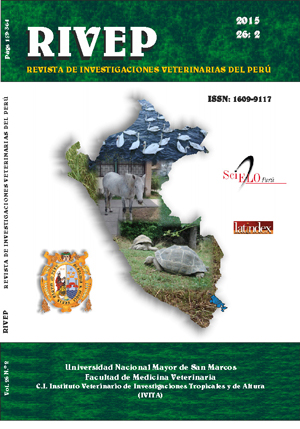Cryptosporidiosis in dogs bred in rural communities of Puno, Peru
DOI:
https://doi.org/10.15381/rivep.v26i2.11010Keywords:
Cryptosporidium sp, protozoan, zoonotic, prevalence, dogs, Ziehl-Neelsen modifiedAbstract
The aim of this study was to determine the prevalence of Cryptosporidium sp in dogs of rural communities located in the districts of Ajoyani, Carabaya province and Palca and Santa Lucia, Lampa province, in Puno, Peru. Fecal samples were collected (n=123) from apparently healthy dogs of both sexes, older than one month. The ZiehlNeelsen modified technique was used for the diagnosis of Cryptosporidium sp. The overall prevalence was 26.8 ± 7.8% for Cryptosporidium sp and without significant association between the presence of the protozoa with the district, sex and age. The results show the presence ofCryptosporidium sp in dogs evidencing a possible zoonotic risk.Downloads
Downloads
Published
Issue
Section
License
Copyright (c) 2015 Noemit Celis S., Amanda Chávez V., Francisco Suárez A., Néstor Falcón P., Viviana Fernández P.

This work is licensed under a Creative Commons Attribution-NonCommercial-ShareAlike 4.0 International License.
AUTHORS RETAIN THEIR RIGHTS:
a. Authors retain their trade mark rights and patent, and also on any process or procedure described in the article.
b. Authors retain their right to share, copy, distribute, perform and publicly communicate their article (eg, to place their article in an institutional repository or publish it in a book), with an acknowledgment of its initial publication in the Revista de Investigaciones Veterinarias del Perú (RIVEP).
c. Authors retain theirs right to make a subsequent publication of their work, to use the article or any part thereof (eg a compilation of his papers, lecture notes, thesis, or a book), always indicating the source of publication (the originator of the work, journal, volume, number and date).



